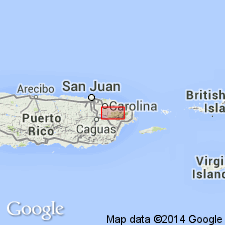
- Usage in publication:
-
- Canovanas Formation*
- Modifications:
-
- Named
- Dominant lithology:
-
- Mudstone
- Sandstone
- AAPG geologic province:
-
- Caribbean region
Summary:
The Canovanas Formation, here named, consists of mudstones and volcanic sandstones. Conformably overlies the Cambalache Formation; conformably underlies the Martin Gonzalez Lava. Maximum thickness is 450 m. Age is Late Cretaceous (Turonian to Santonian) based on Foraminifera.
Source: GNU records (USGS DDS-6; Reston GNULEX).

- Usage in publication:
-
- Canovanas Formation*
- Modifications:
-
- Overview
- AAPG geologic province:
-
- Caribbean region
Summary:
The Canovanas Formation occurs in eastern Puerto Rico and consists of basaltic, volcanic sandstone and mudstone. Maximum estimated thickness is 200 meters. The Canovanas is of Late Cretaceous age.
Source: GNU records (USGS DDS-6; Reston GNULEX).
For more information, please contact Nancy Stamm, Geologic Names Committee Secretary.
Asterisk (*) indicates published by U.S. Geological Survey authors.
"No current usage" (†) implies that a name has been abandoned or has fallen into disuse. Former usage and, if known, replacement name given in parentheses ( ).
Slash (/) indicates name conflicts with nomenclatural guidelines (CSN, 1933; ACSN, 1961, 1970; NACSN, 1983, 2005, 2021). May be explained within brackets ([ ]).

